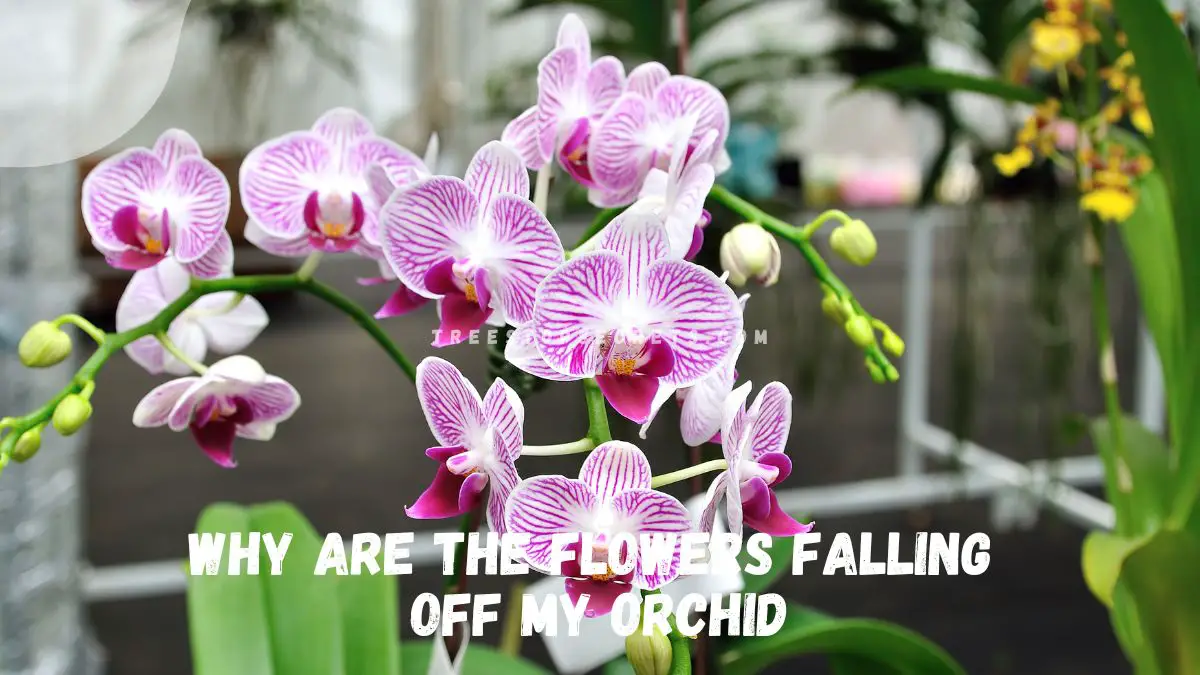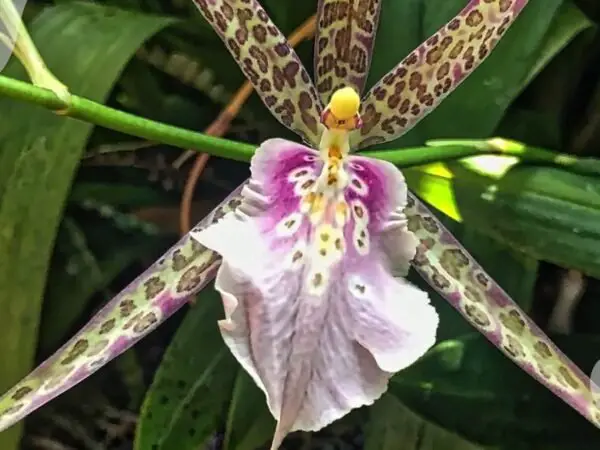Are you worried about your orchid's dropping flowers? Understanding the reasons behind this common issue is key to keeping your plant healthy and blooming. From improper watering and lighting to incorrect temperature levels, various factors can contribute to flower loss in orchids.
Key Takeaways
- Understanding the orchid life cycle is crucial to caring for your plant and anticipating changes.
- Recognizing healthy orchids involves observing vibrant leaves, strong roots, and consistent blooming patterns.
- Flowers falling off orchids can be due to natural shedding, stress, or environmental factors.
- Specific symptoms like yellowing leaves or mushy roots indicate underlying issues that need attention.
- Environmental factors such as temperature, humidity, and airflow significantly impact orchid health.
- To prevent flower drop, maintain proper watering practices, provide adequate light, and choose the right location for your orchid.
Orchid Life Cycle
Bloom Duration
Orchids progress through stages from seed to dormancy, blooming in distinct phases. The natural cycle includes the bloom's onset and eventual falling off.
Understanding how orchids reproduce and bloom aids in appreciating their beauty. Different species have varying bloom durations, with some like Phalaenopsis flowering for up to three months.
Bloom Frequency
Orchid flowers' length of existence varies by species and overall health. Phalaenopsis orchids are known to bloom for extended periods due to their robust health.
Appreciating the beauty of orchid blooms throughout their lifespan enhances the joy of owning these delicate plants.
Recognizing Healthy Orchids
Signs of Vigor
Orchids go through dormancy before blooming again, a natural cycle crucial for their growth. During this period, they conserve energy to prepare for the next blooming phase. Understanding this cycle helps new orchid owners grasp the importance of patience in caring for their beloved orchids.
Phalaenopsis orchids are known for their ability to bloom multiple times in a year, showcasing their resilience and adaptability. This unique characteristic makes them a favorite among intermediate growing orchid enthusiasts. By providing the right conditions and care, these beautiful flowers can flourish repeatedly, bringing joy to many orchid lovers.
Caring for orchids during their blooming and resting phases is essential for maintaining their health. Proper watering, adequate light exposure, and appropriate fertilization are key factors to consider during these stages. New orchid owners should pay attention to these details to ensure their orchids thrive and continue to bloom vibrantly throughout the year.
Common Concerns
Recognizing signs of a healthy orchid plant involves observing its leaves, roots, and blooms regularly. Vibrant green leaves, firm roots, and colorful blossoms indicate a thriving orchid. New orchid owners should familiarize themselves with these indicators to ensure their plants are in optimal condition.
Learning how to recognize when an orchid is thriving requires attentiveness and knowledge of common orchid problems. By monitoring changes in leaf color, root health, and flower development, prospective orchid enthusiasts can identify any issues early on and take appropriate action to address them promptly.
Monitoring your orchid's vitality is crucial for its overall well-being and longevity. Regularly checking for any signs of distress or decline allows orchid owners to intervene quickly and prevent further complications. By staying attentive to their beloved orchids' needs, individuals can enjoy the beauty of these delicate plants for years to come.
Why Flowers Fall Off
Overwatering Issues
Overwatering, underwatering, and light exposure are common issues affecting orchids. Environmental factors play a crucial role in orchid health. Troubleshoot orchid care concerns for optimal growth.
Excessive Light
Recognize signs of overwatering in orchids to prevent issues like root rot and dropping flowers. Proper drainage is essential for preventing overwatering and maintaining orchid health.
Cold Stress
Identify the effects of excessive light on orchids, leading to plant stress. Optimal light conditions are vital for ensuring healthy orchid growth and avoiding potential stress-related problems.
Plant Stress Factors
Cold temperatures can stress orchids, impacting their overall health. Protect orchids from cold stress by ensuring they are shielded from temperature fluctuations. Maintain stable conditions for thriving orchids.
Specific Symptoms Explained
Brown Stem
Brown stems in orchids can result from stress factors like improper watering, low humidity, or inadequate lighting. These stressors hinder plant health and flower production. To mitigate stress, ensure consistent care, such as maintaining proper watering schedules and providing adequate light levels. Creating a stable environment with optimal conditions is crucial for the overall well-being of your orchids.
Yellow Leaves
Yellow leaves on orchids may signal the need for pruning to redirect the plant's energy towards healthy growth. Addressing brown stems promptly can help prevent further stress on the plant. By managing falling flowers and brown stems effectively, you can promote better blooming cycles and overall plant vitality.
Premature Falling
Yellowing leaves in orchids can be caused by various factors, including overwatering leading to root rot. This condition can result in yellow leaves and dropping flowers. Regularly checking for root rot in orchids with yellow leaves is essential to prevent further damage and maintain plant health. Proper care practices are key to addressing these issues and ensuring the longevity of your orchids.
Environmental Impact
Temperature Fluctuations
When the temperature fluctuates, orchid flowers may fall prematurely due to stress on the plant. Orchids are sensitive to sudden temperature changes, which can disrupt their blooming cycle. To differentiate between natural bloom cycles and premature falling, monitor the overall health of the plant. Manage premature falling by maintaining a consistent temperature and avoiding extreme fluctuations to ensure orchid health.
Relocation Stress
Temperature fluctuations can impact orchid health, especially during relocation. Protect orchids from sudden changes in temperature by gradually acclimating them to new environments. The ideal temperature range for healthy orchid growth is typically between 60-80 degrees Fahrenheit. Sudden shifts in temperature can cause stress to orchids, leading to flower drop and overall decline in plant health.
Chemical Exposure
Relocating orchids can expose them to chemicals that harm their health. Minimize stress when moving orchids by ensuring they are not exposed to harmful substances. Acclimate orchids to their new environment slowly to reduce shock and maintain their well-being. Chemical exposure can have detrimental effects on orchids, affecting their growth, blooming, and overall vitality.
Humidity and Health
Chemical exposure can harm orchids by disrupting their growth and flowering patterns. Protect orchids from harmful chemicals by keeping them in a chemical-free environment. Maintaining optimal humidity levels is crucial for orchid health, as excessive humidity can lead to fungal diseases while low humidity can cause dehydration. By creating a balanced humidity level, you can promote the well-being and longevity of your orchids.
Watering Best Practices
Avoiding Root Rot
Maintaining optimal humidity is crucial for healthy orchids. High humidity levels can lead to root rot. To prevent this, ensure good air circulation around your orchid plants.
To maintain the right humidity levels, consider using a humidity tray or a humidifier near your orchids. These tools help create a suitable environment for your plants to thrive.
Humidity plays a significant role in orchid growth and blooming. Insufficient humidity can cause stress to your orchids, leading to issues like flower drop.
Underwatering Risks
To prevent root rot in orchids, it's essential to water them properly. Ensure that excess water can drain out of the pot, preventing waterlogged conditions.
Proper watering and drainage are key factors in avoiding root rot. Make sure your orchid pots have drainage holes to allow excess water to escape.
If you notice signs of root rot, such as mushy roots or foul odors, take immediate action. Trim away affected roots and repot your orchid in fresh, well-draining media.
Light and Location
Ideal Light Conditions
Orchids are sensitive plants that require adequate sunlight to thrive. Underwatering can lead to detrimental effects on orchids, such as stunted growth and poor blooming. Insufficient watering causes stress to orchid plants, hindering their overall health and vitality. Providing the right amount of water is crucial to prevent underwatering issues.
- Risks associated with underwatering orchids:
- Stunted growth
- Poor blooming
- Increased susceptibility to diseases
- Stress caused by underwatering:
- Reduced nutrient absorption
- Dehydration of plant tissues
- Root damage due to lack of moisture
- Importance of adequate water supply:
- Promotes healthy growth
- Enhances flowering
- Supports overall plant resilience
Optimal Locations
Understanding the ideal light conditions for orchids is essential for their successful growth and flowering. Proper positioning of orchids ensures they receive the right amount of light for optimal development. Light exposure directly impacts the health and blooming potential of orchids.
- Ideal light conditions for orchid growth:
- Bright, indirect sunlight
- Avoid direct exposure to harsh sunlight
- Consider placing orchids near east or west-facing windows
- Positioning tips for orchids:
- Rotate orchids regularly to ensure even light distribution
- Use sheer curtains to filter intense sunlight
- Monitor leaf color for signs of light deficiency or excess
- Impact of light exposure on orchid health:
- Influences photosynthesis process
- Affects flower production and intensity
- Regulates overall plant metabolism
Preventing Flower Drop
Consistent Environment
Placing orchids in ideal locations within your home is crucial for their well-being. Select spots with the right balance of light and temperature to ensure healthy growth. Optimal locations are key for preventing flower drop.
When choosing locations, prioritize areas with indirect sunlight to prevent orchids from getting burnt. Avoid placing them near drafty windows or vents that can cause temperature fluctuations. Optimal conditions lead to healthy orchid growth.
To maintain a consistent environment, consider rooms with stable temperatures and avoid sudden changes. Stability in light exposure and humidity levels is essential for orchid health. Consistency promotes robust growth and vibrant blooming.
Proper Care Routine
Creating a stable environment for orchids involves more than just location. Maintain stability in light, temperature, and humidity to support healthy growth. Consistent conditions are vital for flourishing orchids.
Ensure your orchids receive adequate light without being exposed to direct sunlight for extended periods. Monitor temperature levels to keep them within the optimal range for orchid health. Stability fosters strong growth and abundant blooms.
Consistency in humidity levels is key to preventing flower drop in orchids. Regularly check the moisture content in the air around your plants. Stable humidity supports overall health and encourages beautiful flowering.
Addressing Common Issues
Root Rot Solutions
Root rot is a common issue that can cause orchid flowers to fall off. To tackle this problem, establish a proper care routine for your orchids. Consistently water them, fertilize them, and provide adequate light.
For effective root rot solutions, ensure you water your orchids appropriately. Avoid overwatering, as it can lead to root rot. Fertilize your plants with a balanced formula to promote healthy growth.
Regular care is crucial in preventing root rot and maintaining healthy orchid plants. Consistent monitoring of your plants' health and providing the right conditions will help prevent issues like root rot.
Reviving Underwatered Orchids
To revive underwatered orchids suffering from root rot, take immediate action. Explore effective solutions to address root rot, such as repotting the plant in fresh soil. This can help remove any diseased roots and promote new growth.
Learning how to treat root rot and prevent its recurrence is essential for reviving underwatered orchids. Trim away affected roots, sterilize tools between cuts, and adjust watering practices to prevent future issues.
Early detection and intervention play a significant role in managing root rot in orchids. By promptly addressing signs of distress in your plants, you can prevent further damage and increase the chances of revival.
Closing Thoughts
Understanding the delicate balance required for your orchid's well-being is crucial. From recognizing healthy signs to addressing common issues, you now possess the knowledge to navigate the intricacies of orchid care confidently. By implementing the best practices discussed, you can create an optimal environment for your orchid to thrive and minimize the risk of flower drop.
Remember, consistency is key. Regularly monitor your orchid, adjust watering and lighting as needed, and be proactive in preventing potential issues. Your attentiveness and care will not only sustain your orchid's health but also reward you with vibrant blooms that endure. Embrace this journey of nurturing your orchid, and enjoy the beauty it brings into your space.
Frequently Asked Questions
Why do orchid flowers fall off?
Orchid flowers can fall off due to various reasons such as overwatering, insufficient light, extreme temperatures, or natural aging. It's essential to identify the specific cause to address the issue effectively.
How can I prevent my orchid flowers from dropping?
To prevent flower drop, ensure your orchid receives adequate light, proper watering (avoid overwatering), appropriate temperature and humidity levels, and regular fertilization. Inspect your orchid regularly for any signs of stress or disease.
Is it normal for orchids to shed their flowers?
Yes, it is normal for orchids to shed their flowers as part of their natural life cycle. After blooming, the flowers will naturally wilt and fall off. This process allows the plant to conserve energy for future growth and blooming cycles.
What are the common symptoms of an unhealthy orchid plant?
Common symptoms of an unhealthy orchid include yellowing leaves, mold or mildew growth, stunted growth, wilting flowers, and root rot. Identifying these symptoms early on can help you take necessary steps to revive your orchid's health.
How does environmental factors impact orchid flower drop?
Environmental factors such as improper lighting, extreme temperatures, low humidity levels, and poor air circulation can stress an orchid plant, leading to flower drop. Maintaining optimal growing conditions is crucial to minimize this issue.
Image Source: Paid image from CANVA





